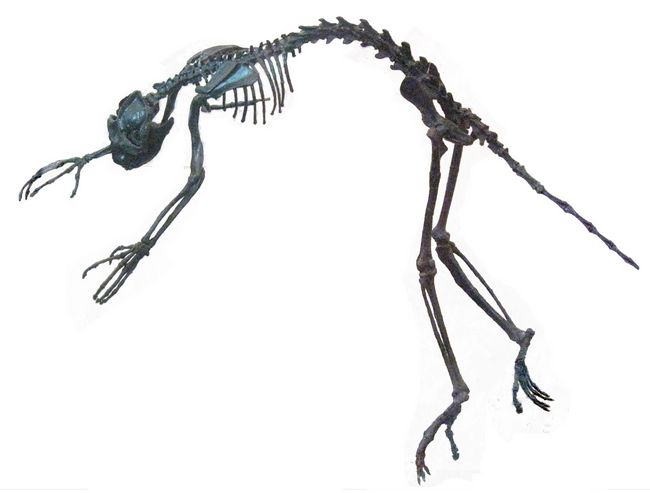Athena Review Image Archive ™
Notharctus tenebrosus skeleton

Skeleton of Notharctus tenebrosus (AMNH; photo: Athena Review)
Notharctus tenebrosus was
an early, adapiform, tree-dwelling primate from the Eocene period,
dating from 54-38 mya. Adapids are considered to have been
lemur-like, as contrasted with tarsier-like omomyids, another group of
early primates. Notharctine primates
are abundant in early (Wasatchian) and middle (Bridgerian)
Eocene faunal assemblages from western North America.
Early Eocene forms are dominated by Cantius, replaced in the middle Eocene by Notharctus and Smilodectes, both found most commonly in southwestern Wyoming.
First described by Leidy (1870), Notharctus tenebrosus, measuring about 40 cm in length, is considered one of the earliest known primates in the lineage of humans. More primitive than living lemurs, Notharctus still had claws, not nails,
The
forelimbs were long and slender. With these it was able to spring from
branch to branch across great gaps. The radius bowed away from the ulna
enabling greater pronation and supination. The fingers were very long,
while the thumb was more robust and rotated medially, opposing the
others. Notharctus held on to branches by grasping them with its hands, not by embedding its claws.
The
hind limbs were long and gracile. The foot had a better thumb
than the hand did. Assuming it behaved like a living lemur, Notharctus practiced vertical clinging and leaping, a new method of locomotion.
References
Gregory W.K. 1920. On the structure and relations of Notharctus, an American Eocene primate. Memoirs of the American Museum of Natural History.
Gunnell,
G. 2002. Notharctine primates (Adapiformes) from the early to middle
Eocene (Wasatchian–Bridgerian) of Wyoming: transitional species and the
origins of Notharctus and Smilodectes.
Leidy, J. 1870. Descriptions of Palaeosyops paludosus, Microsus cupidatus and Notharctus tenebrosus. Proceedings of the Academy of Natural Sciences, Philadelphia 22:111-114.
Copyright © 1996-2020 Rust Family Foundation (All Rights Reserved).